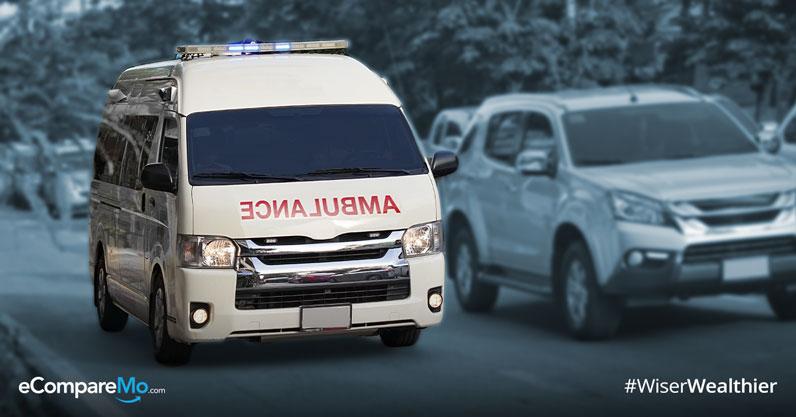There’s An Ambulance Behind You. Here’s What You Should NEVER Do
5 min readIt seems the kamote drivers are at it again. Just recently, one of them caused a patient aboard an ambulance to slip into a coma.
A Facebook video shared by a certain Jing Zamora revealed how barbaric and calloused Filipinos are—even when there are emergency vehicles that urgentlyly need to pass through.
As seen in the video, she was rushing her mother to a hospital in Laguna after the latter fainted.

Unfortunately, the driver of the vehicle couldn’t get past through the traffic because their lane was occupied by counterflowing cars and motorcycles. Despite the flashing lights and the blaring siren, drivers and riders didn’t budge and pave the way for the emergency vehicle.
According to a report by ABS-CBN News, the patient fell into coma because she didn’t receive the proper medical attention on time.
Judging by the video, it seems like Filipinos are painfully ignorant of the traffic rules whenever there are emergency service vehicles nearby.
So in case you didn’t know what to do or you slept through your driver’s license test, here are the things you should do—and should not do—whenever there’s an emergency vehicle passing through.
It’s in the law
Did you know that it’s in the law that ambulance and other emergency vehicles have the right of way during times of distress? If not, then this is a good time to brush up your knowledge.
According to Article 5 Section 49 of the Republic Act No. 4136, drivers must give way to passing police cars, ambulances, and firetrucks when they are in service.
Dubbed the “right of way for police and other emergency vehicles,†the entire section says it all: “Upon the approach of any police or fire department vehicle, or of an ambulance giving audible signal, the driver of every other vehicle shall immediately drive the same to a position as near as possible and parallel to the right-hand edge or curb of the highway, clear of any intersection of highways, and shall stop and remain in such position, unless otherwise directed by a peace officer, until such vehicle shall have passed.â€
Meanwhile, the Metro Manila Council has certain lanes for the use of emergency vehicles during urgent situations.
According to the Metropolitan Manila Development Authority (MMDA), drivers must free up the fourth lane from the sidewalk for multi-lane roads like Edsa and Commonwealth Avenue.
For other types of roads, here are the special lanes that can be hijacked by police, medical, and fire teams during emergencies:
- Two-way roads with center island: the nearest lane to the center island
- Two-way roads with no center island: the nearest lane to the middle of the road
- One-way roads: the leftmost lane
What does this mean? If you’re driving and you see an ambulance behind you or hear its wailing sirens, then you must move to the rightmost side of the road, turn on your hazard lamps, and stay on the right until the vehicle has passed.
If you’re in an intersection and you see an ambulance from your behind, do not block the intersection and find your way to the rightmost side of the road. For vehicles turning left, you might want to just go straight instead and move to the right.
(Read: What To Do If You Get In An Accident With An Emergency Vehicle)
Under any circumstances, do not turn left when there’s an emergency vehicle from behind because the innermost lanes are for passing vehicles and they can commandeer it for convenience.
This also applies to oncoming traffic so make sure you’re on the outer lanes as much as possible. If you miss a left turn, let it slide and just find the nearest U-turn so you can go back to your original destination.
What about during heavy traffic and everyone’s just stuck on congested roads? The most prudent way to approach this situation is to stay calm and wait for the opportunity to move to the outermost lanes. Don’t forget to use your turn signal so everyone will know that you’re planning to make way for an emergency vehicle.
Once the emergency vehicle has passed, do not tailgate them just so you can breeze through other vehicles. We all know that motorcycle riders love doing this but some car owners have the audacity to follow suit.
Before you even say that there are times where it’s impossible to do any of these, this video will prove you otherwise:
No rest for the wicked
Would you like to know what happens when you either deny an ambulance its right of way or you tailgate any emergency vehicle?
Tailgating emergency vehicles entails a penalty of P500 for a first offense, P750 for a second offense, and P1,000 for third and succeeding offenses.
Going back to the issue of counterflowing vehicles blocking an ambulance, MMDA head Jojo Garcia said that the owners caught on camera will be penalized by the law. He said that they will be hounded and slapped with counterflowing and obstruction.
(Read: You Can Have A PH Driver’s License Valid For 10 Years If You Possess This Trait)
Drivers caught going against the flow of traffic will be meted with P2,500 and three-month suspension of driver’s license. Meanwhile, obstruction of the road will set them back by P1,000.
They might also face additional penalties that will arise from other traffic violations as well as civil liabilities arising if the family of the patient in the ambulance decide to press charges.
At the end of the day, this goes beyond fines and obedience of the law. As people sharing the road with one another, it’s our responsibility to make sure that there’s access for people who need it the most. This means yielding to an ambulance if there’s one and letting them pass so others may live.
Every time you steer clear of an emergency vehicle’s way, you are helping save lives.
